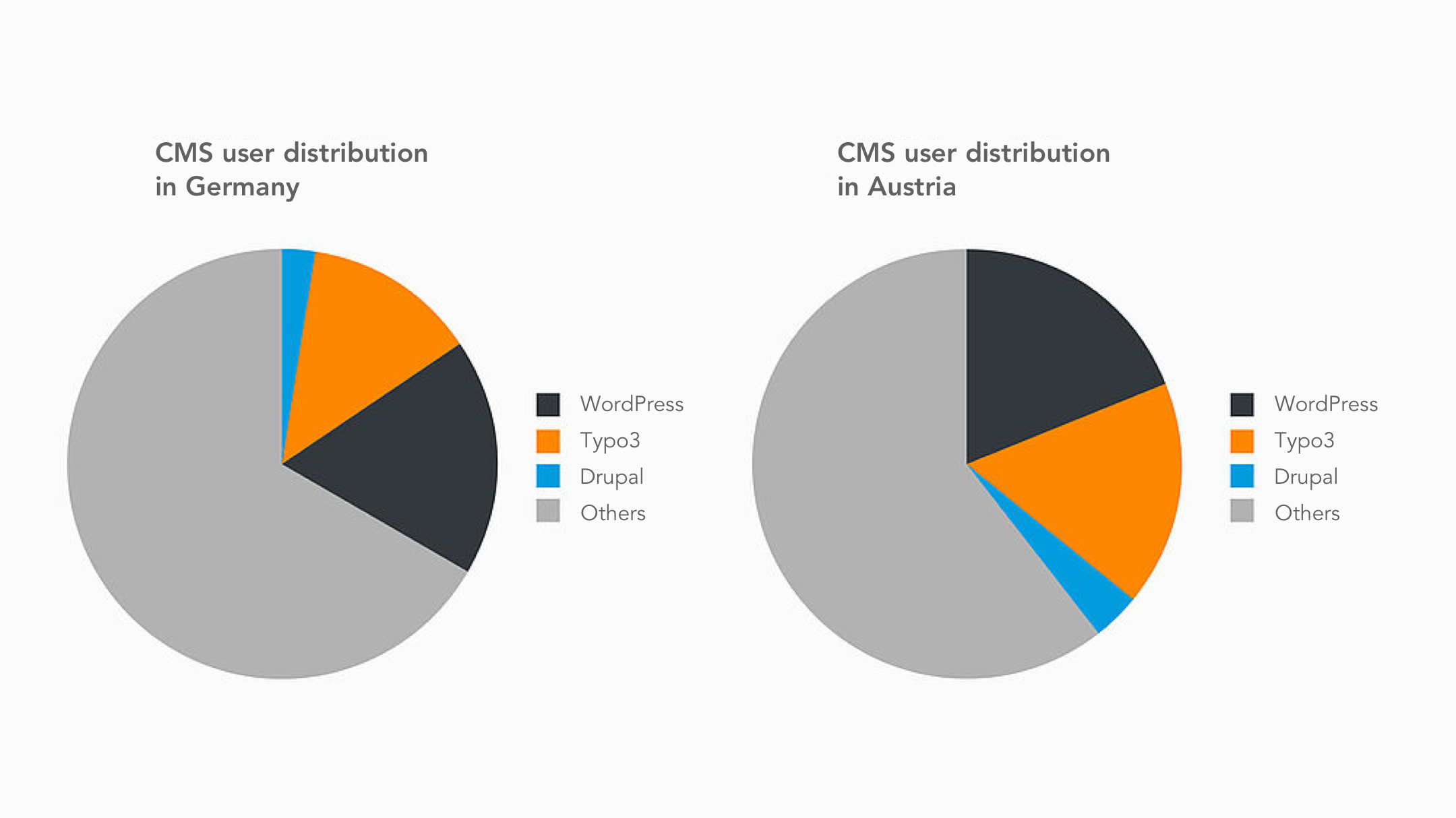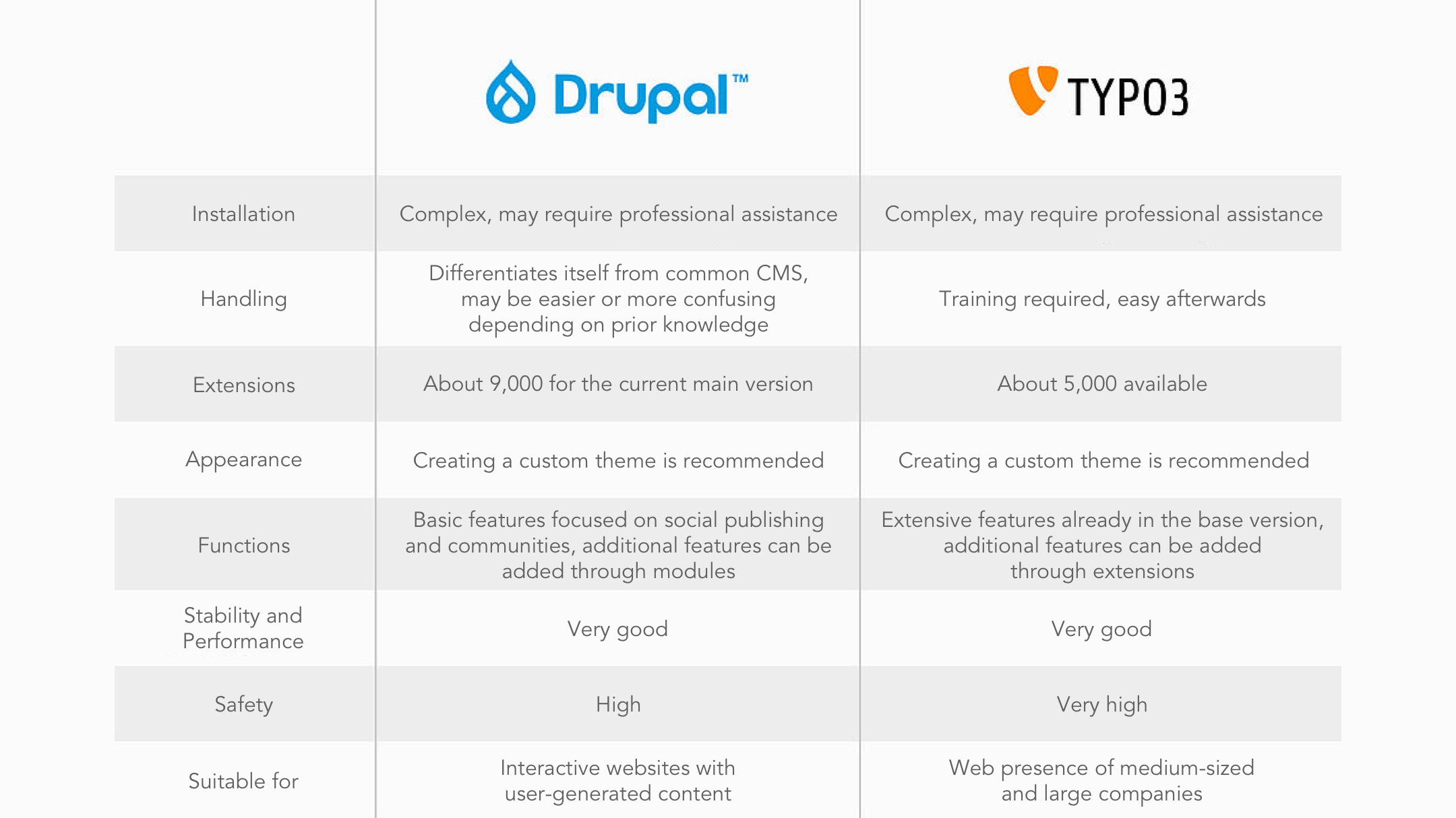Create, edit, design and archive: With a content management system you can easily create your new website. But which one is the best? In the article "Making the right choice: Which is the best CMS?" we explained which CMS is best for which needs. In the article "The CMS Comparison Part 1: Typo3 vs. Wordpress" we discussed the pros and cons of two of the most popular systems. Now we take a closer look at Drupal and compare it to our favorite - who wins this time?
Drupal is the 3rd most popular content management system worldwide, far behind the strong market leader WordPress: With a market share of 2.7%, it is well ahead of Typo3, whose international market share is only 0.6%. In the German-speaking region, Drupal's share remains relatively constant at 2.6% in Germany and 3.5% in Austria, but Typo3 clearly outpaces its competitor with 13% and 17% respectively. This makes Typo3 the most used system in this country after WordPress.

In the next two sections, we will look at exactly how the two content management systems differ: Information about the programs' origins, technology, and key features will give you a clear picture and make it easier to decide which software is better for you. If you prefer something short and sweet, here is a summary of our comparison.

Drupal was developed in 2000 as a contact platform for a student dormitory and released to the public the following year as an open source project under the GNU General Public License by one of its main developers, Belgian Dries Buytaert. With the help of an extremely active developer community, the forum grew to become one of the world's leading web content management systems in the years that followed. In addition to large international conferences, the DrupalCons, which take place twice a year, the community meets in regional and national, mostly theme-based camps.
A new major version, Drupal 9, is scheduled for release this year. While it has been the case in the past that a major release has meant many necessary adjustments and some resulting problems for users, this will change in the future: Starting with Drupal 8, all future versions will be compatible, making an upgrade much easier than before.
Drupal is mostly written in PHP, and since version 8 the system also uses components of the PHP framework Symfony. You can use SQLite, MySQL/MariaDB and PostgresSQL as databases, and additional modules allow you to use MS SQL Server and Oracle. The basic version of Drupal is quick to install, but the system cannot be used without massive extensions: According to the modular principle, all necessary modules must be installed and configured, and professional support is required for implementation.
Unlike most CMSs, Drupal does not have a strictly separate backend for editing web pages. Instead, the integrated role management allows editing directly in the frontend, so that authorized users can edit pages directly. For novice users, this intuitive interface greatly reduces training time. However, for users who have worked with other systems, it is usually a challenge.
The CMS has a modular design: This means that a slim core with very few functions can be individually expanded with various extensions. There are currently almost 9,000 of these modules for the current version 8. Due to the high effort and expertise required to find all the appropriate extensions, Drupal also offers installation profiles. These so-called distributions offer a specific selection of additional modules for typical use cases such as government, publishing or online shops.
There are about 500 templates for Drupal 8 that you can use to change the look of your website. However, these are usually subject to the limitations of a distribution, so creating your own theme is usually recommended.
Drupal has a strong focus on social publishing: It supports the creation of communities using interactive elements such as blogs, forums and tag clouds, as well as a sophisticated system of roles and permissions. In addition, the system has common functions such as multilingualism, multi-site and multi-domain capability, as well as interfaces for connecting to other programs such as CRM and ERP systems. However, because they are built using modules, they require special attention during upgrades and, if necessary, various customizations.
The CMS's sophisticated caching system ensures good performance even with high traffic. In addition, sites built with Drupal load faster than most due to its lightweight core. However, this advantage is often offset by the large number of extensions required.
Drupal's Long Term Support (LTS) provides two major releases with security updates, the end of which is announced some time in advance. In addition, the Drupal Security Team maintains the security of the current core and modules published on drupal.org, handling reported security issues and ensuring that they are fixed. Despite all the security efforts and the relatively low risk of successful attacks, many people still associate the CMS with the known cases: In 2014 and 2018, critical vulnerabilities appeared under the name "Drupalgeddon 1 and 2", which allowed hackers to intercept confidential content or gain unrestricted control over the entire system.
In 1997, Dane Kasper Skårhøj began developing software that would allow customers to create and maintain websites without any knowledge of HTML. After a brief use as a commercial system for an advertising agency, the first official version of Typo3 was released in 2001 as an open source project under the GNU General Public License. Three years later, the Typo3 Association was founded: This non-profit association based in Switzerland coordinates the ongoing development of the CMS.
Typo3 is regarded as an Enterprise Content Management System that is often used - especially in Europe - to create and manage complex Internet projects. But why?
The core of TYPO3 is written in the scripting language PHP, and the system specific configuration language TypoScript is also used. The database can be MySQL, MariaDB, PostgreSQL or Oracle. Since the initial setup requires specialized knowledge, you should contact a digital agency.
You will need a specialist - internal or external - to install and maintain a Typo3 website, but not for editorial maintenance. Allow some time for training, after which you will be able to use the full functionality of the CMS.
There are currently about 5,500 extensions in TER alone, the public extension repository, written by an estimated 2,000 programmers.
There are only a few design templates for Typo3, most companies have developed their own theme.
Typo3 impresses with its wide range of functions: Even the basic version includes numerous options such as multilingualism, multi-site and multi-domain capability as well as complex rights management. A workflow management function simplifies the approval process, and open interfaces allow easy integration with classic business applications such as CRM and ERP systems.
Typo3 impresses with its clean code base, which meets even the most demanding requirements and ensures flawless, stable performance. The caching function, which comes standard, also has a positive effect on page loading times.
The Typo3 Association is responsible for the security of the system. Their security team monitors further development and responds promptly with security updates when problems arise. There is also a regular Long Term Support (LTS) version, which is provided with security and maintenance updates free of charge for 3 years. After that, it is possible to use the version for another 3 years as part of a paid Extended Long Term Support (ELTS) version. As long as you use one of these supported versions, the risk of damaging attacks on your website is low.
Drupal is more of a web application framework than a traditional content management system. It is suitable for projects whose requirements are clearly defined and very individual. Thanks to its lean but functional core, an experienced web developer can use modules to tailor the system to your exact needs. Typo3, on the other hand, is a powerful CMS for complex tasks: Its features, which are usually already available in the basic version, are perfectly adapted to the requirements of the classic corporate environment - functional, secure, stable.
As with the WordPress vs. Typo3 comparison, we recommend weighing things up: Both content management systems are highly qualified tools with advantages and disadvantages. The crucial question is what you want to use them for. Drupal convinces for very specialized websites and in the area of social communities. Typo3 is popular with medium and large companies.
If you need support in making your decision, we would be happy to help you with a personal consultation. Simply contact us for a customized solution by phone at +49 711 184 206-0 or by email at hello@wus.de.